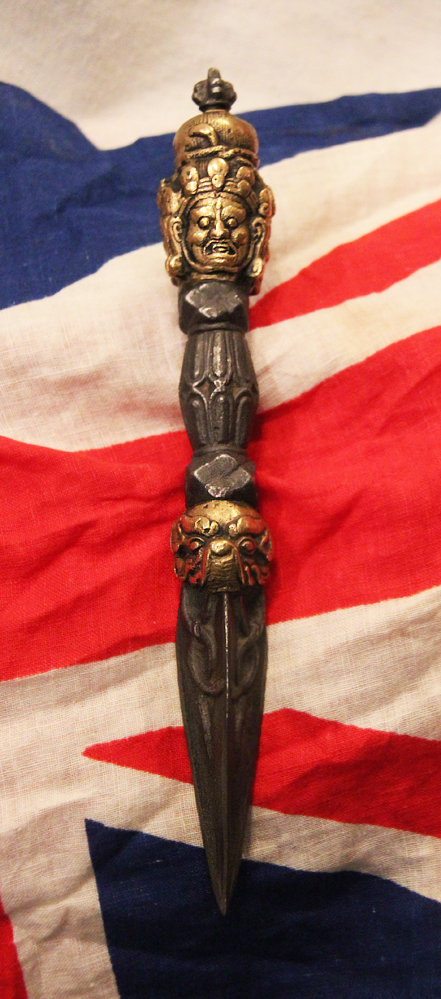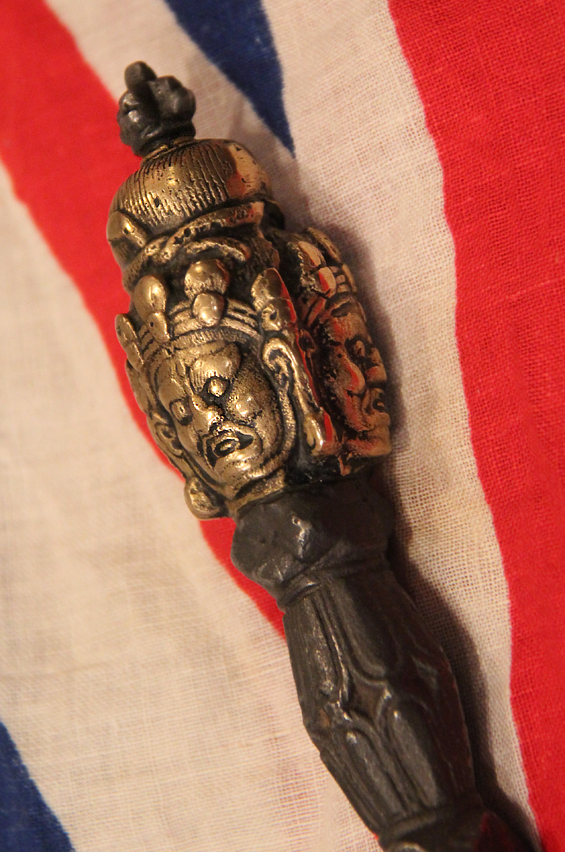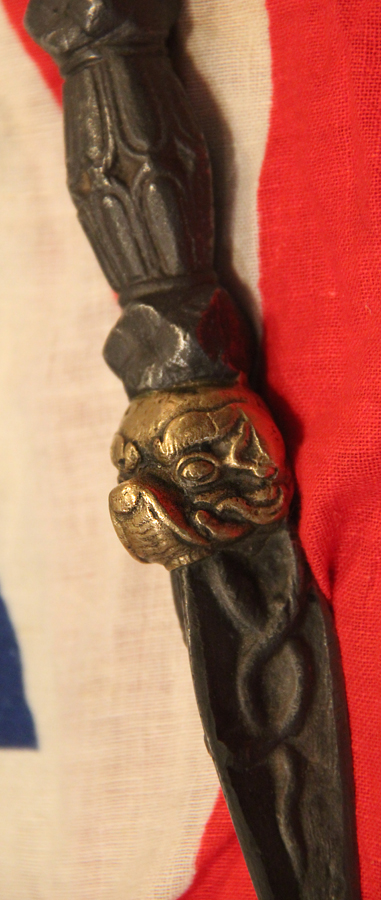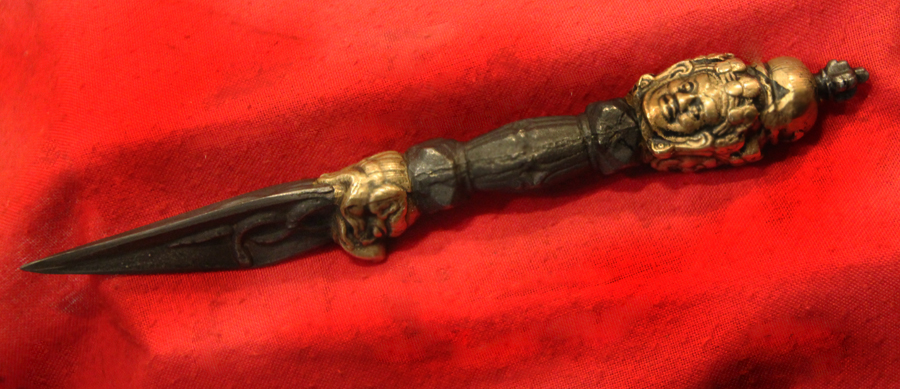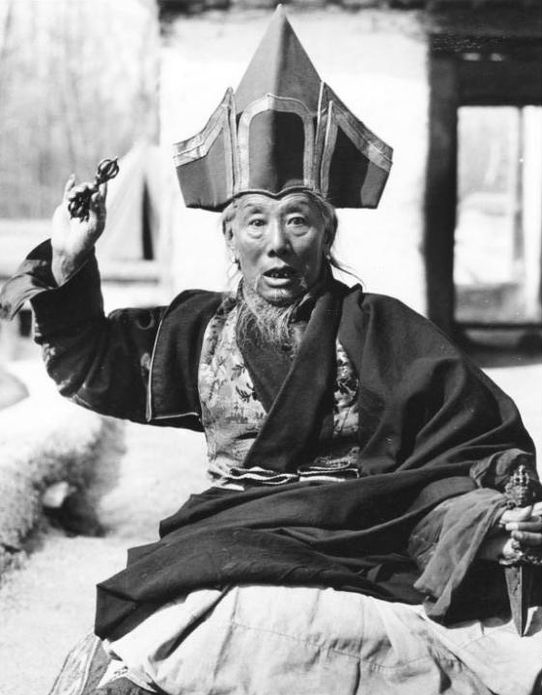A Superb, Tibetan Shamen's Phurba or Kila, The Demon Killer Dagger. Potentially A Truly Unique Gift Idea, a Fabulous Addition, or Indeed Start, of An Amazing Collection of Esoteric, Rare Artifacts. In Brass and Terrestrial or ‘Sky’ Iron
The magical demon killing dagger of Tibet. The magic of this Magical Dagger apparently comes from the effect that the material object has on the realm of the spirit. A most special artefact of once most rare interest. Just only around 150 years ago, original items of Tibetan Buddhist shamanism were all but unknown, to all of the greater public of Western civilisations, due to Tibet being a near closed society. But now, more is becoming universally known, and thus it is creating incredible interest to this amazing, unique, kind and generous peoples of the Himalayas.
The art of tantric magicians, shamens or lamas lies in their visionary ability to comprehend the spiritual energy of the material object and to willfully focus it in a determined direction. . . The tantric use of the phurba encompasses the curing of disease, exorcism, killing demons, meditation, consecrations (puja), and weather-making. The blade of the phurba is used for the destruction of demonic powers. The top end of the phurba is used by the tantrikas for blessings. With the three faces of Vajrakila in brass, steel midsection of a vajra brass face of followed by an iron three sided pointed blade. The fabrication of kila or Phurba is quite diverse. Having pommel, handle, and blade, kila are often segmented into suites of triunes on both the horizontal and vertical axes, though there are notable exceptions. This compositional arrangement highlights the numerological importance and spiritual energy of the integers three and nine.
Kila may be constituted and constructed of different materials and material components, such as wood, metal, clay, bone, gems, horn or crystal.
Like the majority of traditional Tibetan metal instruments, the kila is often made from brass and iron terrestrial and/or meteoric iron. 'Thokcha' means "sky-iron" in Tibetan and denote tektites and meteorites which are often high in iron content. Meteoric iron was highly prized throughout the Himalaya where it was included in sophisticated polymetallic alloys such as Panchaloha for ritual implements. The pommel of the kila often bears three faces of Vajrakila, one joyful, one peaceful, one wrathful, but may bear the umbrella of the ashtamangala or mushroom cap, ishtadevata (like Hayagriva), snow lion, or stupa, among other possibilities. The handle is often of a vajra, weaving or knotwork design. The handle generally has a triune form as is common to the pommel and blade. The blade is usually composed of three triangular facets or faces, meeting at the tip. These represent, respectively, the blade's power to transform the negative energies known as the "three poisons" or "root poisons" of attachment/craving/desire, delusion/ignorance/misconception, and aversion/fear/hate.
As a tool of exorcism, the kila may be employed to hold demons or thoughtforms in place (once they have been expelled from their human hosts, for example) in order that their mindstream may be re-directed and their inherent obscurations transmuted. More esoterically, the k?la may serve to bind and pin down negative energies or obscurations from the mindstream of an entity, person or thoughtform, including the thoughtform generated by a group, project and so on, to administer purification.
The kila as an iconographical implement is also directly related to Vajrakilaya, a wrathful deity of Tibetan Buddhism who is often seen with his consort Diptacakra. He is embodied in the kila as a means of destroying (in the sense of finalising and then freeing) violence, hatred, and aggression by tying them to the blade of the kila and then transmuting them with its tip. The pommel may be employed in blessings. It is therefore that the kila is not a physical weapon, but a spiritual implement, and should be regarded as such. The kila often bears the epithet Diamantine Dagger of Emptines. As Beer (1999: p. 277-278) states, transfixing kila , charnel ground, scorpion and Padmasambhava:
The sting of the scorpion's whip-like tail transfixes and poisons its prey, and in this respect it is identified with the wrathful activity of the ritual dagger or kila. Padmasambhava's biography relates how he received the siddhi of the k?la transmission at the great charnel ground of Rajgriha from a gigantic scorpion with nine heads, eighteen pincers and twenty-seven eyes. This scorpion reveals the k?la texts from a triangular stone box hidden beneath a rock in the cemetery. As Padmasambhava reads this terma text spontaneous understanding arises, and the heads, pincers, and eyes of the scorpion are 'revealed' as different vehicles or yanas of spiritual attainment. Here, at Rajgriha, Padmasambhava is given the title of 'the scorpion guru', and in one of his eight forms as Guru Dragpo or Pema Drago ('wrathful lotus'), he is depicted with a scorpion in his left hand. As an emblem of the wrathful kila transmission the image of the scorpion took on a strong symbolic meaning in the early development of the Nyingma or 'ancient school' of Tibetan Buddhism”
For reference; To see a similar example on display in the Met.
Ritual Dagger (Phurba) and Stand
Tibet
late 14th–early 15th century
On view at The Met Fifth Avenue in Gallery 253
Ritual utensils are the essential tools of Tibetan Vajrayana Buddhism practice, used to drive away the delusions that act as impediments to enlightenment. The phurba (Sanskrit: kila) dagger seen here was designed to symbolically consume the triple poisons of ignorance, greed, and delusion that impede spiritual progress. The phurba is the embodiment of the Vajrakila Buddha, who is empowered to suppress all evil in the world. Its ritual use is first described in the Vajrakilaya Tantra, a Vajrayana text dating to the eighth century or earlier.
https://www.metmuseum.org/art/collection/search/75826
Code: 22515

